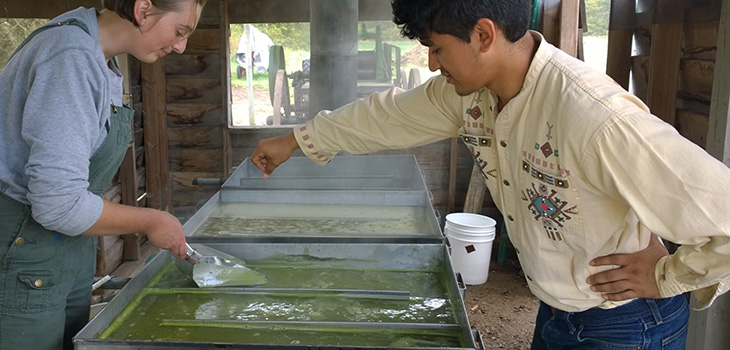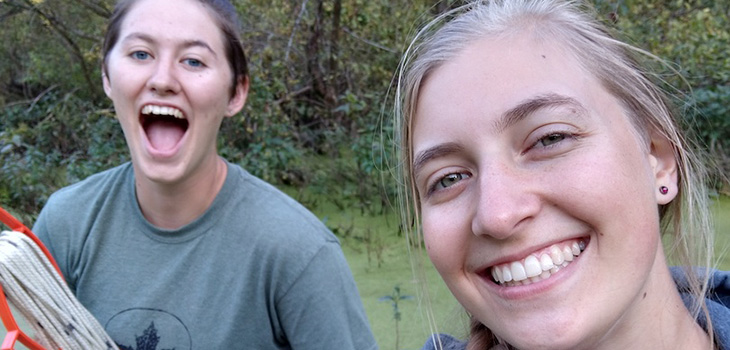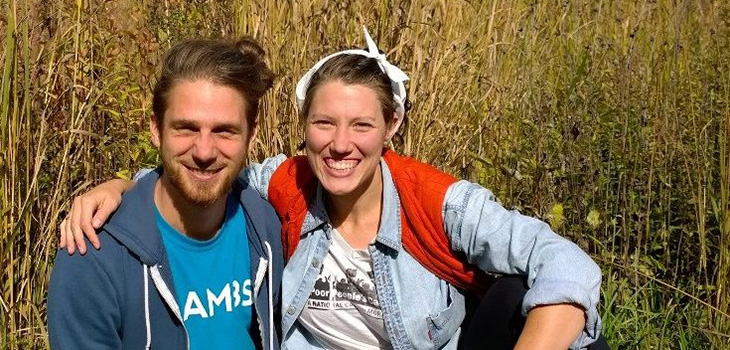When Andy Rieth was a young boy growing up, he would often spend a week at his aunt’s and uncle’s house on the lake with his close cousins. They would wake when the sun came up, swim and fish all day long, and run through acres and acres of the wooded land.
But before they could jump in the lake, his aunt would make him and his cousins go around the property and identify each tree in a journal. “Of course, being 8 or 9 years old, that was painful,” Andy says with a grin. They would examine the trees’ bark, leaves and surrounding areas for identification clues. His aunt then checked their journals before rewarding their work by letting them loose: free to play and swim.
“Now I appreciate what a cool thing it was and what she was trying to do,” reflects Andy.
This aunt who taught and coached her nephews for developing an appreciation for the environment was Mary Jane Rieth, Merry Lea Environmental Learning Center of Goshen College’s co-founder.
As Women’s History Month is coming to an end this March, we celebrate Mary Jane and her steadfast vision for Merry Lea. Her visionary work manifested in significant contributions, from organizational operations to providing funding, making Merry Lea what it is today.
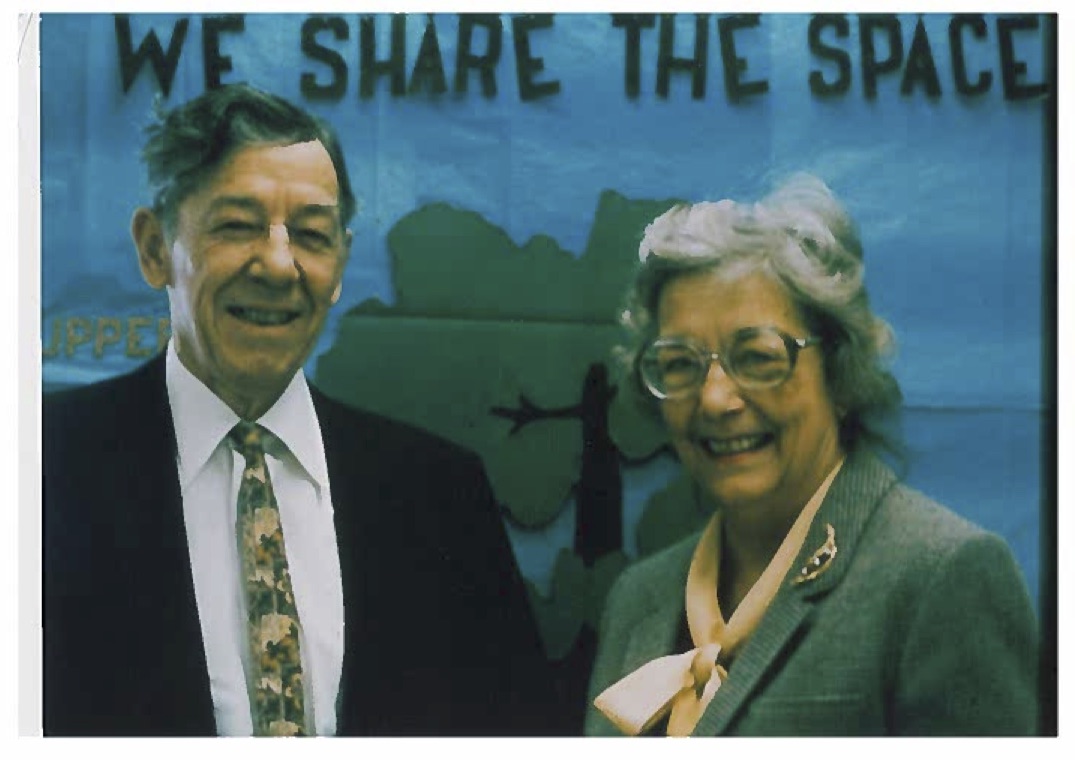
Forming Merry Lea
Merry Lea’s name is a homonym inspired by the names of our founders, Mary Jane and Lee Rieth. Meaning “happy meadow,” it is fitting that Mary Jane’s reference would come first.
“Mary Jane was a very outgoing, gregarious person,” says Andy. “She had a big smile and she had a very hearty laugh that I remember as a little boy.”
When Mary Jane’s husband Lee Rieth bought the first parcel of land in 1964, much to her surprise, she became intimately involved in the organization right away.
“Mary Jane bought into and supported Merry Lea,” says Bill Minter, director of land management. “There was no sense that Merry Lea was [only Lee’s].” Bill first interacted with the Rieths through consultation work on Merry Lea, and continued consulting on their home property periodically, before joining Merry Lea’s team 30 years ago.
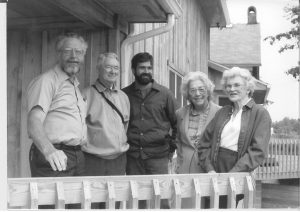 Mary Jane became a member of the board when the non-profit organization was originally the Merry Lea Nature and Religious Foundation. Bill and former Executive Director Luke Gascho have spent much time in the Merry Lea archives and testify that the record clearly shows her active involvement in stewarding Merry Lea.
Mary Jane became a member of the board when the non-profit organization was originally the Merry Lea Nature and Religious Foundation. Bill and former Executive Director Luke Gascho have spent much time in the Merry Lea archives and testify that the record clearly shows her active involvement in stewarding Merry Lea.
Bill describes the detailed finance ledger books she kept and the numerous letters she typed: every single correspondence that Lee sent to outside members was typed by Mary Jane. Luke praises how Mary Jane dictated the minutes of the original Merry Lea board, providing “a very helpful backdrop for getting Merry Lea established.” Using tabs and a three-ring binder system, her organization and notes helped Merry Lea maintain continuity.
“She was very active in the business of Merry Lea. Mary Jane was right in there,” says Bill.
Even though Andy didn’t grow up around Merry Lea, he complements these contributions by describing Mary Jane’s and Lee’s ability to think long-term into the future. “What is going to be here 50 years from now? 100 years?” he explains.
This forward-thinking manifested in many ways for the Rieths.
One of which was caring for their own property on Klinger Lake in southern Michigan. They procured and planted native tree species across their 23 acres. Mary Jane also maintained large gardens full of blooming local plant species. Donned in pedal pushers and gardening gloves – or sometimes just her swimsuit – she’d tend her gardens meticulously to appear as a natural setting, as opposed to the neatly manicured English or French gardens.
50 years later, Andy and his family now live on this Klinger Lake property, benefiting from the arboreal setting today.
Looking to the future also involves digging into the past. “She was the one in our family who kept track of family history,” says Andy. “This passion for genealogy was consistent with thinking about legacies and future generations.” Mary Jane’s love of genealogy took her to Washington, D.C. to peruse the archives kept by the Daughters of the American Revolution, to Salt Lake City to see the meticulous records kept by the Mormons, to libraries in Europe and to old cemeteries, taking detours to gather information along the way.
Understanding and tracking family history tends to bring a greater awareness for what lies ahead for the family’s generations.
This sentiment may initially be blurrily connected to the value of sustainably utilizing and protecting natural resources, but it comes into focus as Andy describes a vivid memory of Mary Jane talking about Rachel Carson’s book “Silent Spring.” A watershed book that spurred an environmental movement during the 60s and 70s, “Silent Spring” documents the harmful effects caused by synthetic pesticides upon the natural world: from species extinction to human health.
“I remember [Mary Jane] talking about it to me as a little boy…and being passionate about wanting us to care,” says Andy. It had an apparent impact upon Mary Jane, using Rachel Carson’s enlightening words to express her own views of making the world a better place.
Instead of leaving a legacy through children, Mary Jane and Lee saw Merry Lea as “their opportunity to carry on a legacy for future generations,” explains Andy.
Stewarding a Vision
Being able to pursue long-term investments stems from an ability to be a visionary. Mary Jane stewarded Merry Lea by never losing sight of how Merry Lea’s ecosystems and programs can positively impact people: a vision she wholly shared with Lee.
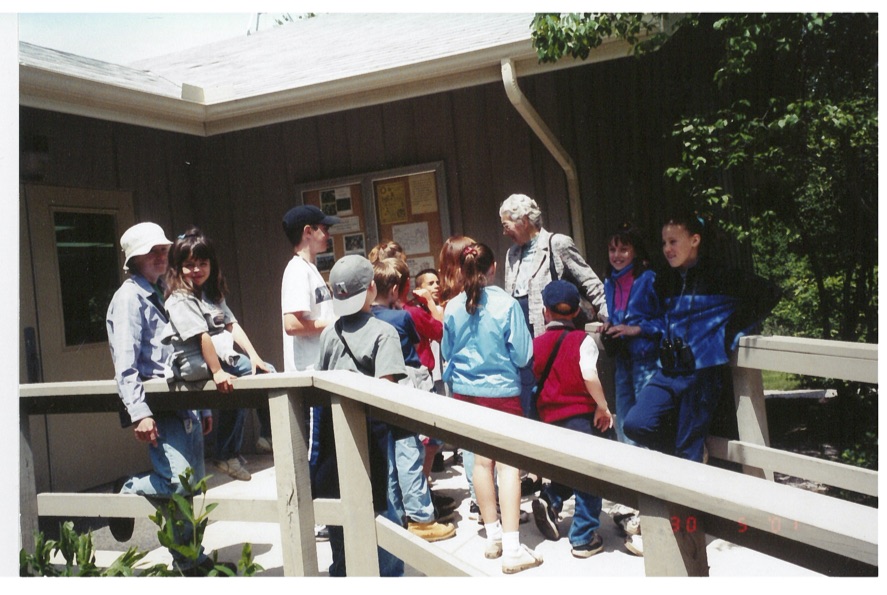
“[Mary Jane] had a passion for education, having children experience nature in the outdoor setting,” says Luke. This was shared by both Lee and Mary Jane, but Bill emphasizes how “she had a real heart for kids to get involved outside…especially disadvantaged kids.”
Mary Jane’s role on the board was important for executing the vision of Merry Lea. As the Rieths poured passion and money into this non-profit they founded, they shepherded the vision by looking for “institutional connection for synergy,” says former Executive Director Larry Yoder. The Rieths initiated the process of giving the organization to a college that could sustain Merry Lea into the future.
Larry was the first executive director to arrive in 1981 after the Rieths donated Merry Lea to Goshen College. Decades later, this bold vision of aligning Merry Lea with a higher learning institution continues to provide novel opportunities for Merry Lea to be a place for people to connect with nature: from being an outdoor laboratory for students and faculty, to establishing residential collegiate programs that bring sustainability, agroecology and environmental education to life.
Yet in the midst of donating Merry Lea to Goshen College, Mary Jane’s commitment to the organization remained strong.
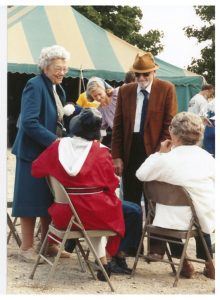 Many Merry Lea team members who interacted with Mary Jane mention that being physically present on the land was important to her. Kerry Goodrich, Merry Lea’s property supervisor since 1980, recalls Mary Jane coming down to plant flowers, clean windows or walk the trails with him. Her affinity for trees led her to fund tree planting projects through state grants or pay for them herself. Kerry estimates that he and Larry planted 10,000-20,000 trees on the property, from oaks to pines to other varieties.
Many Merry Lea team members who interacted with Mary Jane mention that being physically present on the land was important to her. Kerry Goodrich, Merry Lea’s property supervisor since 1980, recalls Mary Jane coming down to plant flowers, clean windows or walk the trails with him. Her affinity for trees led her to fund tree planting projects through state grants or pay for them herself. Kerry estimates that he and Larry planted 10,000-20,000 trees on the property, from oaks to pines to other varieties.
She continued to be present as a board member as well. The original board of Merry Lea was dissolved in 1980 for the organization to become part of Goshen College. Afterwards, Mary Jane and Lee served on the advisory committee with Bill’s parents and other community members. She later became a founding board member in the late 1990s for the new Merry Lea Board as it exists today.
Her support of programming extended well beyond Lee’s death in 1984. Mary Jane was welcoming and unpretentious – from tending gardens in her swimsuit to inviting Merry Lea staff up at the lake for retreats – as much as she was tenacious in forwarding the vision of Merry Lea.
There has to be “some vigor and vitality to keep a vision going,” says Luke. After Lee passed, it was Mary Jane who established long-term funding for Merry Lea. With the resources the Rieths acquired from their Rieth-Riley construction business, Mary Jane set up the Rieth Foundation and set aside other investments to support Merry Lea financially. After she died in 2008, the endowment of her estate went to Merry Lea.
These financial decisions and donations were and continue to be incredible gifts. “Merry Lea would not be what it is today if it wasn’t for that critical decision,” says Luke. Larry describes how when the banker asked Mary Jane how much money she wanted to put into the foundation for Merry Lea, she said, “Every penny we can get. We’ve got so much to do down there.”
Luke keenly explains how one can be a visionary, but without any resources, no vision can be actualized. Mary Jane ensured that this would not be a barrier: she “allowed us to be visionaries and carry out the vision,” says Luke.
Despite being the major funder and co-donor of Merry Lea, Mary Jane had great faith and trust in the Merry Lea team and allowed the organization to further the vision in ways she might not have imagined.
“She was able to be part of the strategic planning process in 1998, visioning many of the programmatic things added at that time,” says Luke. In these board meetings, Mary Jane didn’t speak up a lot, but “trusted other board members to make their contributions.” She would express her affirmation directly, but also indirectly in her “willingness to hand off responsibility,” expresses Luke. It is apparent that Mary Jane’s and Lee’s vision was not only executed by the Merry Lea team, but resonated with them as well, able to grow and actualize it authentically.
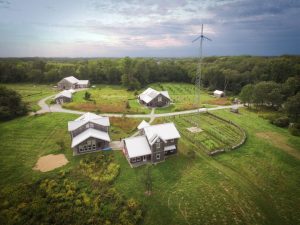 When Rieth Village was first discussed, Mary Jane initially thought of it as a retreat center. As the team and the board created it to be a collegiate facility, she was very supportive. Luke would often drive her to and from board meetings and he mentions how he asked her “very directly” if she supported the collegiate direction. “And she would say, ‘No that’s ok. I’m ok with the switch’…she saw real movement happening and supported that,” Luke describes with gratitude.
When Rieth Village was first discussed, Mary Jane initially thought of it as a retreat center. As the team and the board created it to be a collegiate facility, she was very supportive. Luke would often drive her to and from board meetings and he mentions how he asked her “very directly” if she supported the collegiate direction. “And she would say, ‘No that’s ok. I’m ok with the switch’…she saw real movement happening and supported that,” Luke describes with gratitude.
As her health declined and she moved into a retirement facility in Goshen, she sold her property at Klinger Lake, the property that she cared for for years. She used the proceeds of that sale into the building of Rieth Village: another indication of her support and trust.
Supporting that strong commitment to Merry Lea’s vision was an equally strong dedication to her husband Lee.
“To know Mary Jane, you have to understand that at the end of the day, she was very devoted to Lee,” explains Andy.
“A big part of her involvement in Merry Lea was because she knew it was a passion of Lee’s, and wanted to see his vision continue and brought to fruition,” Andy says. “That was something she saw as his legacy and something they wanted to leave behind, in part because they didn’t have any children of their own.”
This devotion served as a source of strength and tenacity, rather than a limitation of potential.
As renovations were completed on the Michael Yoder Dome and the Farmstead barn, Luke and Bill both describe how delighted Mary Jane was to see these projects and program potential. Luke says, “But the way she would express it to me would be, ‘Oh, Lee would be so pleased.’”
This nod to her late husband was interpreted by the Merry Lea team as “a signal that we were on the right track,” says Bill. “It might have been different than what she imagined or what they talked about, but we were meeting this larger vision.”
Luke sees this sign of respect for her husband “as a reminder of how they worked together so closely, and it was honoring for her to be thinking about how Lee couldn’t be around to see this but would’ve been pleased.”
“There certainly was a love story there,” says Andy. “Lee was an interesting guy in that he had these different views of the world. He also had very brittle health all his life.”
These “different views” refer to the seemingly contradictory lifestyle of co-owning Rieth-Riley, a construction business, but having strong interest in protecting the environment. Andy describes how Lee hated the increasing development of farmland, of rich soils being paved over. This sentiment of sustainably using resources with an appreciation for the environment might not have been shared or understood by others, but was certainly shared by Mary Jane.
Lee also had diabetes since childhood and was one of the first patients to receive insulin in the world. Mary Jane went to school at Ball State and Purdue Universities to become a dietician, and first met Lee when he was a patient at a hospital she worked at. Being scientifically oriented and able to care for him when his blood sugar levels got low, Mary Jane was “the perfect partner for him,” according to Andy.
Both Larry and Luke would visit with Mary Jane throughout the years to keep her updated on the happenings of Merry Lea. They both chuckle as they recall how at the end of their conversations, she would often remark, “Boys, let’s get to work!”
As the Merry Lea team continues the legacy and heritage the Rieths bestowed – to engage people of all ages in learning at the intersections between nature, ecology and spirituality – it’s time to get to work.

